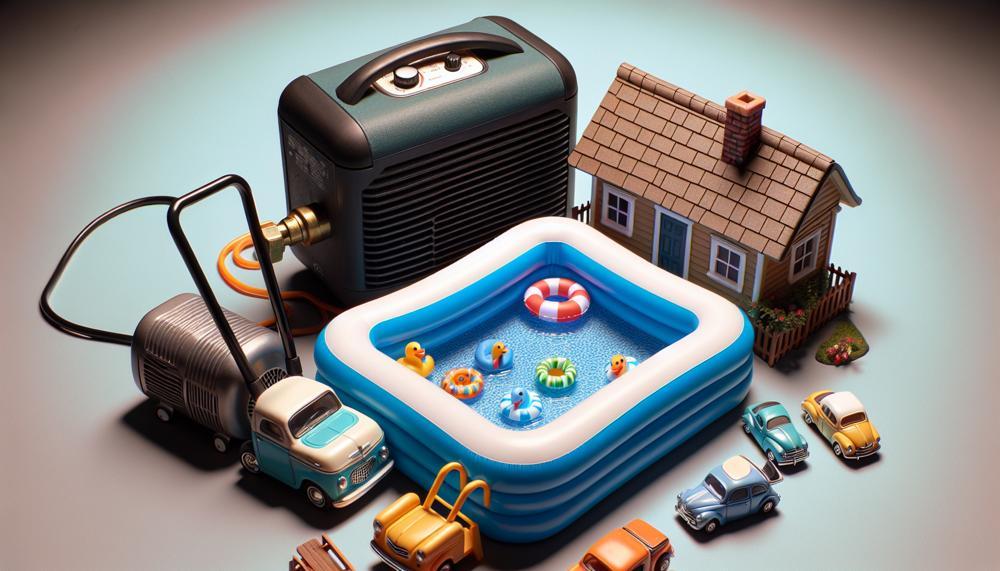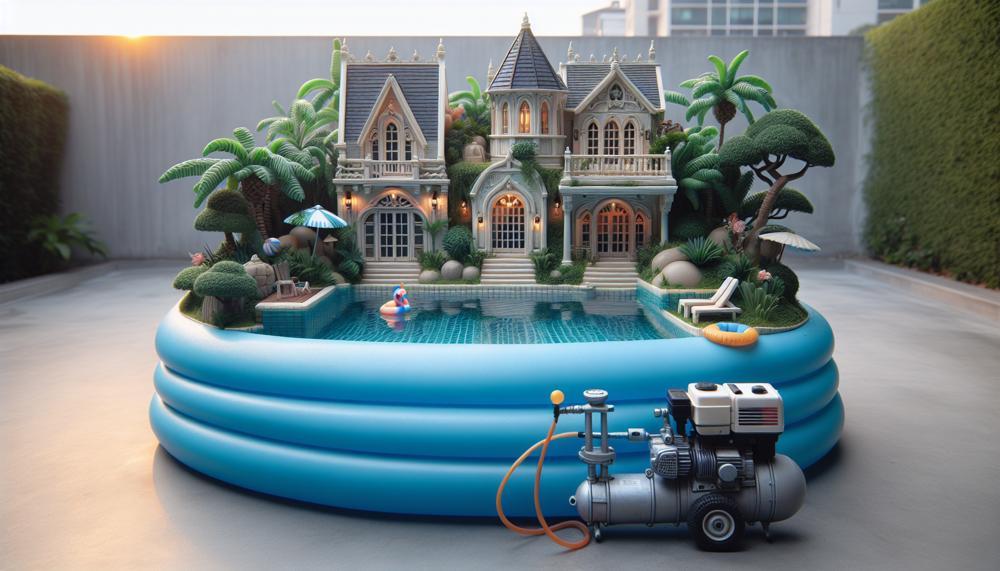Are you tired of the tedious and time-consuming task of manually inflating your pool every summer? In this blog post, we will explore the benefits of using an air compressor. It can inflate your pool. With the scorching heat and long days ahead, it’s crucial to have a quick and efficient way to set up your pool.
By utilizing an air compressor, you can save valuable time and energy while achieving a inflated pool. We’ve got you covered with all the necessary information for a stress-free pool setup. We’ll provide essential equipment and safety precautions.
Get ready to dive into a hassle-free summer with these key points:
- The perks of using an air compressor for pool inflation
- The must-have equipment for the process
- Step-by-step instructions on how to properly inflate your pool
- Safety tips and precautions to keep in mind
So, let’s explore now.
Can I Use An Air Compressor To Inflate A pool?
Contents
- 1 Can I Use An Air Compressor To Inflate A pool?
- 2 Why Use An Air Compressor And Not Other Means To Inflate A Pool?
- 3 Factors to Consider Before Getting Air Pump for Inflatable Pool
- 4 Types Of Air Compressor You Can Pick From
- 5 How To Inflate A Pool Using An Air Compressor?
- 6 How To Turn Off The Compressor
- 7 Can You Inflate A Pool With A Vacuum?
- 8 Conclusion
Inflating a pool with an air compressor may seem easy and convenient. However, it is not without safety concerns.
To ensure safe inflation, use the right compressor. Carefully monitor the pressure and electricity usage.
It is also essential to check for potential contaminants that could pose a risk to the pool’s water quality.
Furthermore, it’s vital to take additional safety precautions. For example, wear protective eyewear and keep the compressor away from water sources.
By adhering to these guidelines, using an air compressor to inflate a pool can be a safe and efficient option.
Why Use An Air Compressor And Not Other Means To Inflate A Pool?
Let’s take a closer look at the advantages of using an air compressor:
- Versatility and Power: Air compressors are versatile tools used in various industries for different purposes. They can convert power into potential energy stored in pressurized air, making them powerful tools that can be used for multiple tasks.
- Increased Efficiency and Cost Savings: By using an air compressor to inflate a pool, you can save both time and effort compared to other methods like manual or electric pumps. The increased efficiency can also lead to cost savings on energy expenses in the long run.
- Improved Safety: In certain applications, using an air compressor can improve safety by reducing the risk of accidents or injuries. For example, using an air compressor to inflate a pool eliminates the need for manual pumping, which can cause strain or fatigue.
- Multiple Uses: There are at least 15 different ways that air compressors can be utilized, making them a valuable investment for any household. Aside from inflating pools, they can also be used for tasks such as inflating tires, sandblasting, and even scuba diving.
- Customizable Options: When selecting an air compressor, there are various factors to consider such as required air pressure and flow rate, portability, and power source. This allows for customizable options based on specific job requirements.
- Different Types Available: There are various types of air compressors available in the market, including reciprocating, rotary screw, centrifugal, axial flow, diaphragm, scroll, portable and stationary models. This provides users with a wide range of options based on their needs and preferences.
- Oil-Free or Oil-Injected Options: Air compressors also come in either oil-free or oil-injected options, depending on specific job requirements. This allows for versatility and adaptability in different applications.
- Power Source Options: Air compressors can be powered by electricity or gas, making them suitable for various job locations and needs.
Factors to Consider Before Getting Air Pump for Inflatable Pool
Before you rush to get an air pump for your inflatable pool, make sure you consider these important factors first. Don’t choose any air pump and end up with a regretful purchase. Take the time to understand your pool and your needs before making a decision.
- Firstly, size and compatibility are crucial. You want to make sure that the air pump is a perfect fit for your pool size and type of valve. This will ensure efficient inflation and avoid any frustration or damage.
- Next, it’s important to check the recommended air pressure for inflating your pool. This will prevent any uneven inflation or potential damage to your pool. Don’t risk ruining your pool by neglecting this crucial factor.
- When it comes to the power source, you have options. You can choose between electric, battery-operated, or manual pumps. Consider your preferences and the availability of power outlets before deciding on the right power source for you.
- Features are another key aspect to consider when choosing an air pump. Make sure to look for nozzle options, automatic shut-off, and deflate function to make your pool experience even more convenient and enjoyable.
- Durability and warranty should also be taken into account. Invest in a durable air pump with a warranty to ensure its longevity and provide peace of mind in case of any defects or malfunctions.
Types Of Air Compressor You Can Pick From
There are notable distinctions between portable and stationary air compressors in terms of their features and capabilities, particularly when it comes to inflating pools. These differences can greatly impact which type is more suitable for this task.
- Portability: As the name suggests, portable air compressors are designed with convenience in mind, allowing for easy transportation from one location to another. They are typically smaller in size and often come equipped with wheels or handles for effortless movement. On the other hand, stationary air compressors are larger and heavier, making them less practical for frequent transportation.
- Power: Portable air compressors typically have lower horsepower and smaller tanks compared to stationary models, which can affect their overall power and ability to inflate larger objects. In contrast, stationary air compressors come with larger tanks and higher horsepower, making them better suited for heavy-duty usage and inflating larger objects.
- Durability: Stationary air compressors are built to withstand regular and prolonged use, making them more durable than portable models. While portable air compressors may not be as robust or long-lasting, they can still handle occasional usage.
- Noise Level: Due to their size and design, stationary air compressors tend to be quieter than portable models. This can be advantageous for those residing in noise-sensitive areas or needing to use the compressor in close proximity to others.
- Cost: Generally, portable air compressors are less expensive than stationary models due to their smaller size and lower power output. This makes them a more cost-effective option for those who only need an air compressor for occasional use.
A portable air compressor may be the preferred choice for inflating a pool because of these differences. It offers a more budget-friendly option. It is easier to transport and can still provide sufficient power for most pool sizes.
However, if you have a larger pool or plan to use the compressor, a stationary model may be better. This is because it is more durable and has higher power output.
How To Inflate A Pool Using An Air Compressor?
If you want to properly inflate your pool using an air compressor, there are a few key steps you need to follow. These steps will ensure the safety and effectiveness of the inflation process. Let’s dive in and take a closer look at how you can achieve this:
| Step 1: Choose the perfect air compressor | First things first, make sure to select an air compressor with enough power and the correct nozzle attachment for inflating your pool. This will ensure that you have the right tools for the job and avoid any complications or delays. |
| Step 2: Prepare your pool for inflation | Before proceeding with inflation, it’s important to close all valves and thoroughly check your pool for any holes or tears. Fixing these issues beforehand will save you time and frustration later on. |
| Step 3: Connect the air compressor | Once your pool is ready for inflation, it’s time to connect the air compressor. Make sure to securely attach the hose to the main inflation valve on your pool. This will prevent any air from escaping and ensure a smooth inflation process. |
| Step 4: Monitor pressure and avoid over-inflation | As you turn on the air compressor, keep a close eye on the pressure gauge. It’s important not to over-inflate your pool, so stop once you reach the recommended PSI level. This will prevent any potential damage to your pool. |
| Step 5: Check for even inflation | To ensure a inflated pool, it’s important to check for any bulges or uneven areas. If you notice any, release some air and adjust . |
| Step 6: Test for leaks | |
| Step 7: Store the air compressor properly | After use, it’s important to properly store the air compressor away from water sources. This will prevent any potential hazards or damage and ensure that your air compressor is ready for future use. |
By following these steps, you can safely and effectively inflate your pool using an air compressor. Remember to take safety precautions. Check the pressure gauge. Periodically check for even inflation.
How To Turn Off The Compressor
To properly turn off an air compressor after inflating a pool, it is crucial to follow these steps:
- First, confirm that the pool is fully inflated by checking the pressure gauge or pressing on the sides for firmness.
- Next, switch the nozzle to the exhaust side and slowly release any remaining air.
- Once all the air has been released, disconnect the nozzle from the valve.
- Turn off the air compressor.
- Unplug the air compressor from the power source and allow it to cool down before storing it away.
- Finally, properly store your air compressor in a dry and safe place for longevity and safety.
By following these steps, you can relax and enjoy your newly inflated pool. It is important to adhere to these instructions to ensure the safety of yourself, others, and your equipment.
There are a few additional tips and context to keep in mind when turning off an air compressor after inflating a pool:
- It is recommended to use an air compressor with a nozzle attachment specifically designed for inflating pools. This will make the process easier and more efficient.
- Before using the air compressor, ensure that it has the correct attachments and a suitable PSI rating for your inflatable pool.
- Choose a flat and clear surface to place your pool before inflating it. This will help prevent any damage to the pool.
- Connect the air compressor to the valve on your pool and set it to the recommended PSI level. Keep an eye on the pressure gauge while inflating to avoid overinflating and causing damage.
- Safety precautions, such as wearing protective eyewear, should be taken when using an air compressor.
- The time it takes to inflate a pool varies depending on its size and the power of the air compressor, typically ranging from 5 to 20 minutes.
- To quickly deflate your pool, simply switch the nozzle to the exhaust side.
Can You Inflate A Pool With A Vacuum?
Yes, it is indeed possible to utilize a vacuum to inflate a swimming pool. Here are the steps you should follow for proper inflation:
- Select a wet/dry vacuum with a blower function.
- Connect the vacuum’s hose to the blower outlet and the other end to the pool’s inflation valve.
- Ensure that the pool is dry and clear of any debris or sharp objects.
- Activate the blower function and begin filling the pool with air, moving in a circular motion around the pool.
- Keep an eye on the pressure gauge and do not exceed the maximum recommended pressure.
- Once the pool is fully inflated, turn off the vacuum and remove the hose.
- Check for any leaks or areas that may require more air, and manually add air if needed.
- Store the vacuum in a secure location for future use.
Additional pro tips:
- Use specific attachments for better control and efficiency.
- Monitor PSI levels to avoid over-inflating, which can cause damage to the pool or equipment.
- Always read and follow manufacturer’s instructions for proper usage and maintenance of your vacuum.
Inflating a swimming pool using a vacuum may sound like a simple task, but there are some important factors to consider. For instance, using a wet/dry vacuum with a blower function is crucial. It allows for efficient inflation without damaging the pool or equipment.
Additionally, it’s vital to ensure that the pool is completely dry and free from any debris or sharp objects. This prevents potential damages.
Conclusion
In conclusion, using an air compressor to inflate your pool offers many benefits. These include increased efficiency, enhanced safety, and versatility.
You can inflate your pool with minimal exertion by selecting the appropriate type of compressor. Ensure a clean air supply. Check pressure and electricity usage. Take necessary safety measures.
Furthermore, it is crucial to consider factors such as size, compatibility, power source options, features, durability, and warranty before purchasing an air pump for your inflatable pool. This will help you make an informed decision.
Just remember to follow the proper steps and take necessary precautions for smooth and safe inflation.







